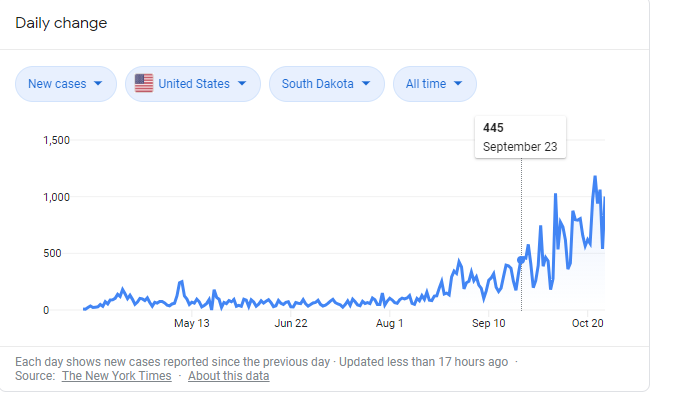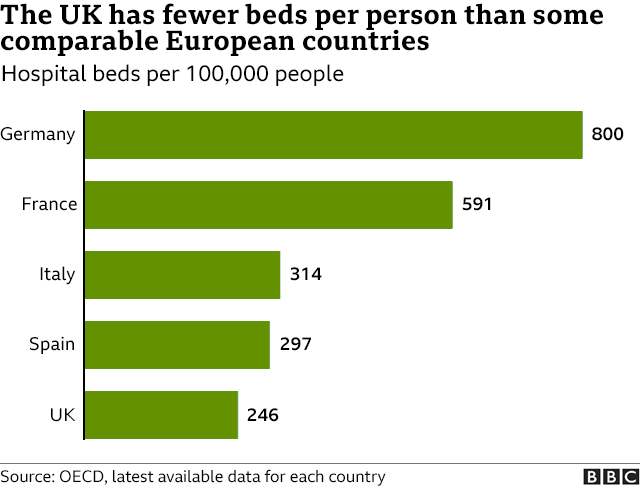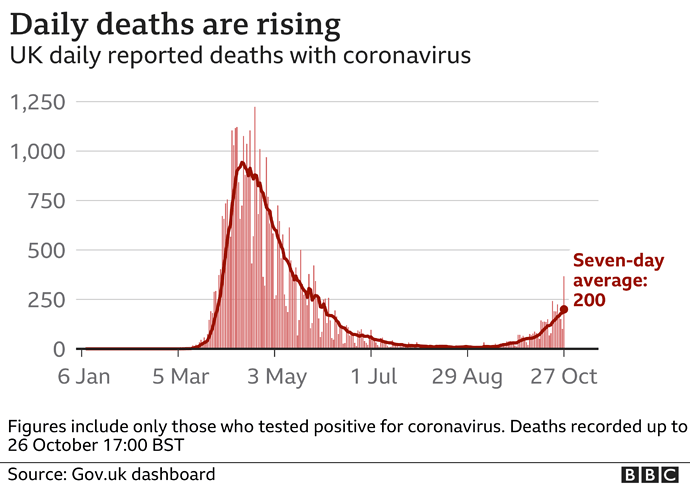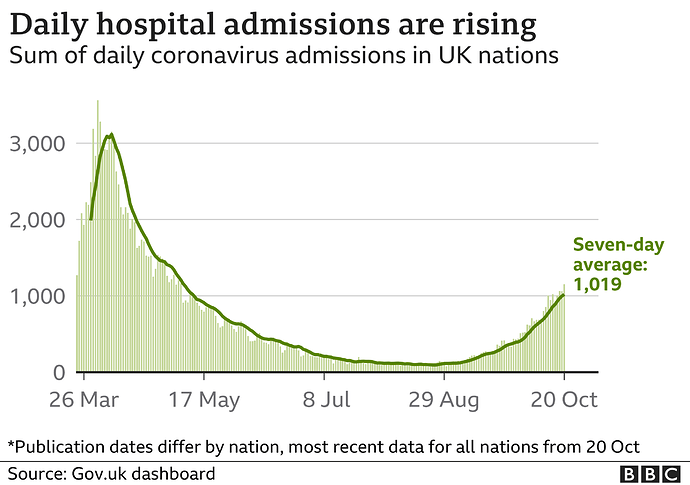You’re still way behind the trailblazers, the UK, who’ve been filming people on their way to work an average of 40 times per person per day for decades, another bonus of having a Murdoch-owned popular press instilling fear of crime into the population on a daily basis for the past 50 years.
That’s the only thing Orwell missed. That we would all line up to spend a hundred bucks a month to put Big Brother in our own pockets.
Or that people would pay (through viewing adverts) for the privilege of providing detailed status updates on what they were doing at any given time.
I mean all joking aside mouth breathing has to spread more than nose breathing just based on the trajectory of the exhalation.
It may be a negligible difference or it may be significant, I don’t think it’s been studied, but surely there’s a difference.
More holy hell. Several states near or above spring New York State 14 day positive sums. Precisely MO and MS with slightly negative 7 day slopes.
This is by far the worst and most widespread crest of the pandemic in the USA so far.
(note update is 10/26 not 10/20)
I find Emily Oster quite a bit more credible than this hit piece. Having primary schools closed and colleges open is a catastrophe.
Yeah we’ve known and said this for months. I mean it’ll be proven or generally accepted as a valid method to control this
Are the ND/SD numbers a result of the multiple generations of Covid being spread since Sturgis? Or just that they’re states that have refused to do anything to mitigate?
Likely a combination of both I suppose.
The more I think about this, the angrier I get. It’s an interesting study of how easy it is to use uncertainty to manipulate an analysis. If you pretend that closing schools is the default and reopening them is a change, then you can look at any amount of data, find the weak spots, and say that you can be sure, so let’s do the safe thing and keep schools closed.
But it’s equally valid (maybe more valid) to view offering public education as the default and shutting down schools as the policy shift. And public schooling is an incredibly important public service, so shutting it down has an immense and known cost. The trade off is to incur a huge, known cost because we can’t be sure that there aren’t huge benefits too. Sounds less wise when you put it like that.
The truly bleak part is that the hit piece acknowledges, in passing, that everyone agrees that opening schools is better for children, but that it might have some negative (but unquantifiable) impact on adults. So why not harm children so that adults can continue to be wildly, wildly irresponsible in every other area of life and suffer a bit less for it.
And then the social justice angle is outright obscene. Another example of weaselly arguments that can be made to say anything. The people who suffer the most from school closures are low-income families who aren’t WFH. Everyone in my social circle is working from home and parenting in shifts, or else creating private homeschooling pods with real teachers. Good fucking luck doing that if you are a single parent working a retail job in person.
I asked Steven Millman the ND/SD question and he came back that it’s 99% Sturgis, for what it’s worth.
This is tradeoff you’re writing about is vastly more honest than Oster’s nonsense about children magically not spreading the disease.
You are starting at a result and working backwards. The data should be neutral.
I’m not saying what the right answer is but the methodology of the economist types is trash.
Going to stay on the ND/SD thing. Here’s Steven Millman’s Covid update for August 9th about Sturgis. Here’s the graph for SD. Looks like Steven was off by about a week or so, as numbers started ticking up around Sept 23rd-ish.

August 9th COVID Update: The Sturgis Motorcycle Rally – A Perfect Storm for a Public Health Emergency
Short Version: The Sturgis Motorcycle Rally in SD, due to it’s sheer scale, lack of mitigation measures, and length of stay is likely to kick off a massive public health crisis in South Dakota, possibly by the time it ends. It is highly likely to kick off a new national surge in cases by early September that could last for weeks, followed three weeks later by a new rise in the rate of deaths.
tl;dr – you’d expect nothing less from me at this point. Pull on those chaps and let’s get started. This could end up being one of the worst ideas concocted since the pandemic began.
As you’ve no doubt been seeing in the news, there is a massive event going on in the tiny town of Sturgis, South Dakota, population seven thousand right now. The 80th Annual Sturgis Motorcycle Rally (https://www.sturgismotorcyclerally.com/), running from August 7th to August 16th, may end up being the world’s largest public gathering since the outbreak of the pandemic. Organizers originally expected as many as 800,000 motorcycle enthusiasts to show up but, as with the Trump rally in Tulsa, the pandemic appears to have scared many away. Current estimates suggest that about 250,000 people travelling from all over the country are attending the rally. The organizers made the decision recently that this year, no media passes would be distributed.
You might be thinking, “That’s a lot of people to have crowding into one place while there’s a pandemic with massive community spread going on.” And you’d be right. Events like this represent a near-perfect breeding ground for the virus both in terms of the opportunity to spread the disease, and the opportunity for the disease to be carried to new populations nationally. Much worse is the fact that the event is long enough to spawn two or three generations of the virus and allowing people to get sick before they’ve left the event. This update is focused on what kind of COVID-19 spread we might expect from the Sturgis Motorcycle Rally and what local and national implications might result.
Let’s start, as always, with the numbers and a set of reasonable assumptions. First, let’s use the reported 250,000 as our population estimate for the event. Next, let’s assume that the population coming to the rally in Sturgis is geographically representative of the United States. They won’t be, of course, and there is strong reason to believe that attendees will be more representative of states where the virus is wide-spread. Nevertheless, as always, I prefer to be conservative with assumptions, so let’s go with the attendees being nationally representative. According to Johns Hopkins University, there are about 3.2 million currently confirmed but unresolved cases of COVID-19 in the US out of the over five million total confirmed cases. That, however, is just a slice of the true underlying activity of the disease. CDC Director Robert Redfield recently said that the true number of cases is likely ten times the tested amount (about 32 million) and a recent article in the Journal of the American Medical Association (JAMA Internal Medicine) suggests that the true number of cases is between six and twenty-four times the number of confirmed cases (https://jamanetwork.com/…/jamainter…/fullarticle/2768834). For the sake of this update, we’ll assume the more conservative 10x estimate from the CDC. This means that about 32 million Americans are likely to be current carriers of the disease, or about 10% of the population (that’s a LONG way from herd immunity, so don’t start). Let’s also assume that only about one-tenth of currently infected individuals in the US would be both healthy enough to travel and early enough in the disease progression to be infectious. Taken together, we are therefore assuming a VERY conservative 1% of Sturgis rally-goers, or 2,500 people, will be infected and infectious on day one of the event. Finally, we will use the CDC’s best guess R0 of 2.5 for the degree of infectiousness. The range of R0 estimates has generally between 1.5 and 5.0 in the literature, and once again 2.5 maybe an underestimate of true spread in this population because the motorcyclist population does not include many children and because they will be packed together in concerts, bars, etc. https://www.cdc.gov/…/2019…/hcp/planning-scenarios.html Current reporting across multiple outlets suggests that virtually no one at the event is wearing masks or social distancing.
Remind yourself from time to time while reading the rest of this update, that these assumptions and estimates represent an almost certainly substantial under-estimate of reality.
So. what happens if 2,500 infected and contagious people show up to Sturgis among the 250,000 revelers? The most important reason that this rally is so dangerous is that people will be there for up to 10 days. Not only does this mean that there is time for up to three generations of disease spread, but it means people who arrive sick or get sick at the event will be at the mercy of local public health services that could be come quickly and completely overwhelmed. More on that later.
2,500 people arriving with an R0 of 2.5, will infect an additional 6,250 people within just a few days. Those people will become infectious within the next 2-3 days, a few days before any of them show symptoms (https://wb.md/2WPms48). On day four or five of the event, these newly infected would start infecting others. These 6,250 infected individuals at the R0 of 2.5 infect an additional 15,625 rally-goers. On the last few days of the event people are starting to get sick, and an additional 15,625*2.5=39,062 are infected as they leave the event for home. So, with very conservative estimates of infection and spread, 2,500 infected cases can become more than 60,000 in just ten days, representing about a quarter of all attendees.
That all sounds horrible, of course, but it gets much, much worse from there. If there are 2,500 people who arrive sick, and an additional 6,250 who become infected shortly thereafter, nearly all of those who develop symptoms from that group will do so AT THE EVENT. Most who show symptoms do so around day five, with some sooner and some later. The average age at these events is between 50 and 60 years of age (https://www.blackhillsknowledgenetwork.org/…/aging…), and about 8.2% of those who contract the virus in that age range end up requiring hospitalization. Younger people are much less likely to require hospitalization, and older people are much more likely. For the purposes of these estimates, let’s assume 8.2% as the average. With 8.2% of 8,750 infected, there would be 717 people who will require hospitalizations from among the rally-goers. We are assuming that those infected with generation two or three make it out before symptoms appear, but there’s a good chance that some from the third generation could also require hospitalizations before they leave town. (https://www.usnews.com/…/odds-of-hospitalization-death…)
717 people would need hospital beds based on these conservative assumptions. In all of South Dakota, there are only 2,741 staffed beds (https://www.ahd.com/states/hospital_SD.html). This event would require one quarter of the entire state’s capacity. And it’s a big state. Sturgis is in the Southwest corner of the state about an hour from Mt. Rushmore. The closest town of any size is Rapid City, about 30 miles away, which has less than 400 staffed hospital beds. The bulk of the staffed hospital beds (about 1,200) in South Dakota are almost 400 miles away in Sioux Falls. There are no population centers relatively closer than Sioux Falls to Sturgis in bordering Wyoming, Nebraska, Montana, or, North Dakota. The beds are also not all empty. In rural SD (like Rapid City), the typical hospital bed occupancy rate is about 22% and in urban areas (like Sioux Falls), the occupancy rate is about 60%. That leaves about 1,600 empty beds that are available in the entire state, and only about 320 in Rapid City. Less than half of what would be needed. This would be a public health disaster of unprecedented proportion in South Dakota. Not only would this likely increase the mortality rate among the COVID populations, it could create a large amount of incidental deaths among those who need to go to the hospital for other reasons but cannot get a bed or a doctor. In order to manage such a crisis, medical staff would need to be flown in from other parts of the country and sick people will need to be moved elsewhere or to makeshift facilities.
And then there are the 60,000 infected people who return back to the rest of the country, carrying the disease with them. This will show up in the national case data as a bump in cases by mid-September, and could look a lot like the surge we are only now coming out of if mask wearing and social distancing do not improve. Deaths will start to appear as a trend in the National data about three weeks later. Let’s not forget that we’re talking about generally older Americans here who are at much higher risk of death from COVID-19. The average age in the US is about 39 years old, compared to the mid-50’s at the Sturgis rally.
And none of this includes the anticipated rise in community spread of COVID-19 from school openings in areas where the disease is not yet contained. Fall is going to be rough. I’d go into details as to exactly how rough it’s likely to get, but this update is already long enough, and it’s my third update in as many days. I need to take a mental health break (and a whiskey or six), so I’ll do the modeling for expected impacts on mortality from Sturgis and school reopenings in the next update.
I am asking readers who manage to get this far to PLEASE be respectful of the potential upcoming loss of life. I, for one, do not find the jokes about “motorcycles for sale – coming soon” to be very funny. And I laugh at videos of cats knocking kittens down stairs. Imagine.
As always, don’t forget I’m not a medical professional or epidemiologist. I’m a professional statistician with too much on my mind.
Actually, what you said was that we should conclude that school closings are a good idea out of a tribal desire to disagree with economists.
I see now that the point was actually about unspecified methodological disagreements.
France will get put in lockdown again later today, not as strict but that may change, obviously. I’ve not been following the thread and I doubt I’m saying anything that’s news, but all the talk of high cases not being as bad news this time round is demonstrably idiotic.
Yes, France was testing more but when cases rise so, inevitably, do hospitalisations. Maybe the multiplier from cases to people in trouble is bigger, but when you’re dealing with this kind of growth then all that buys is a delay of a few weeks, aka fuck all.
This is France’s intensive care occupancy graph, its ‘limit’ is 5,000. It will in all likelihood be breached before whatever Macron does this evening can have any effect. You in the states are obviously suffering from incompetence and stupidity, but you’re not alone.

Curve looks similar, although UK’s is deaths…
We’re being told to expect lower total daily deaths, say 600 per day but a US style extended period of said deaths, like 3 months!
Doh!

Just looked at worldometers, US has done about 400k tests per million people. The only euro countries at or above that level are the UK and Belgium. Denmark is at 875k per million but they’re tiny so meh
And Gibraltar, Faeroe Islands, Andorra, Luxemburg, Monaco, Iceland, Channel Islands and Malta - all Europe and above US in testing… and all small so blah
Edited to add Euro test results take 24/48hrs - US test results are like 5 days if you’re lucky, by which time you’ve probably infected others for 2-3 days anyway e.g. Justin Turner above.
So maybe a USA test is ~50% as useful as a Euro test
UK now has a 1hr test for £120 at local pharmacies


